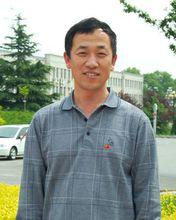人物簡介
 遼寧師範大學王長生教授
遼寧師範大學王長生教授王長生,男,1963年7月出生,博士,教授,博士生導師。多年來一直從事密度泛函理論及其在生物大分子體系中的套用的研究。有原創性研究成果:與楊忠志教授一起建立和發展了有特色的原子-鍵電負性均衡模型和方法(ABEEM),明確地處理了化學鍵和孤對電子,明確地處理了可極化電荷和分子構象的依賴關係,提供了計算電荷分布的新模型,發展了概念密度泛函理論。提出了確定多肽體系中氫鍵強度的新方法。得到國內外同行專家學者的高度關注和廣泛好評,在《中國科學》、《J. Am. Chem. Soc.》、《J. Phys. Chem》、《J. Chem. Phys》 等國內外重要學術雜誌上發表SCI論文30餘篇,SCI檢索引用170餘次,他引130餘次,單篇被最高引用43次。2003年美國化學會出版的《化學評論》(Chemical Review, 2003,103,1793-1873)發表題目為"Computational Density Functional Theory"的評論文章。文中對王長生教授及其合作者在此領域的工作給予了高度評價。國際計算化學最高水平的雜誌Journal of Computational Chemistry在2006年發表一篇文章(2006,27:396),題目為"Optimized and Parallelized implementation of the Electronegativity Equalization Method and the Atom-Bond Electronegativity Equalization Method",專門介紹和評論說,ABEEM方法優於以往的有關方法,並專門編寫了程式。文章在評價我們建立的ABEEM方法和前人建立的EEM方法時說, ABEEM方法是EEM的最好的發展,ABEEM提供了電荷分布的最精確的模型。已經完成國家自然科學基金一項(項目編號:20173025),現正主持國家自然科學基金一項(項目編號:20573049)。科研成果獲得中華人民共和國教育部自然科學獎二等獎一項(2008),獲得中國高校科學技術獎二等獎一項(2002),獲得遼寧省科學技術獎二等獎一項(2002)。
學習工作簡歷
1985年畢業於吉林大學化學系,獲理學學士學位
1990年畢業於遼寧師範大學物理化學專業,獲理學碩士學位
1998年畢業於吉林大學物理化學專業,獲理學博士學位,導師:楊忠志教授,唐敖慶教授
1999.11-2001.11在香港科技大學從事博士後研究,合作導師:吳雲東教授
2003.10-2004.3美國UCDavis大學訪問學者
1985.7至今:遼寧師範大學助教、講師、副教授、教授、博士生導師
主持科研項目
1. 國家自然科學基金項目:經由多肽大分子的長程電子轉移反應的理論化學新方法。
(起止日期:2006.1 ~ 2008.12;基金號:20573049),項目負責人。
2. 國家自然科學基金項目:可用於多肽構象的密度泛函理論模型和程式。
(起止日期:2002.1 ~ 2004.12;基金號:20173025),項目負責人。
3. 遼寧省教育廳基金項目:多肽體系長程電子轉移反應機理的研究。
(起止日期:2007.1 ~ 2009.6;基金號:20060469),項目負責人。
4. 遼寧省教育廳基金項目:快速預測生物大分子性質的可極化電荷力場模型。
(起止日期:2005.1 ~ 2007.12;基金號:2004C019),項目負責人。
研究方向
理論和計算化學。具體包括:1, 密度泛函理論方法及其在生物多肽、核酸大分子方面的套用;2, 有機金屬催化體系、酶催化體系手性催化反應機理的理論研究。
教學工作
1990年至今先後為本科生主講《物理化學》、《物質結構》、《化學動力學導論》
2002年至今先後為碩士和博士研究生主講《基礎量子化學》、《模擬化學》、《理論化學》、《氫鍵理論及套用》
科研成果
1. 概念密度泛函理論及其套用,國家教育部自然科學獎二等獎(2008)
2. 關於分子的電子和空間性質的研究和套用,遼寧省科學技術獎二等獎(2002)
3. 分子電子結構的研究和套用,中國高校科學技術獎二等獎(2002)
4. 密度泛函理論下的電負性均衡及其套用,遼寧省教委科技進步二等獎(1998)
5. 分子軌道理論及其在簇合物中的套用,遼寧省教委科技進步三等獎(1998)
代表性科研論文
1. A new scheme for determining the intramolecular seven-membered ring N-H...O=C hydrogen-bonding energies of glycine and alanine peptides.
J. Chem. Phys., 2005, 123, 024307.
2. Reactions of d group 4 amides with dioxygen. Preparation of unusual oxo aminoxy complexes and theorwtical studies of their formation. J. Am.
Chem. Soc. 2005, 127, 5204.
3. A tungsten silyl alkylidyne complex and its bis(alkylidene) tautomer. Their interconversion and an unuasual silyl migration in their reaction with
dioxygen. Organometallics, 2005, 24, 1214.
4. Electronic states and vibrational frequencies of the triatomic Ga2N, GaN2, and their cations and anions. Chem. Phys. Letters, 2005, 402, 294.
5. Effects of Aromatic Substitutions on the Photoreactions in Mg(C6H nF2X4- n) (X =F, CH3) Complexes: Formation and Decomposition of Benzyne
Radical Cations, J. Phys. Chem. A 2004, 108, 3356
6. Atom-bond electronegativity equalization method and its applications based on density functional theory. J.Theo.Comp.Chem., 2003,2(2):273.
7. Formation and Decomposition of Distonic o-, m-, p-Benzyne Radical Cations from Photolysis of Mg( o-, m-, p-C6H4F2), J.Am.Chem.Soc.,2002,124
(14):3794.
8. Silyl-substituted alkylidenes: preparation of the novel complexes and mechanistic studies of their formation from reactions of alkylidenes with silane and silyl-to-alkylidene migration, J. Mol. Catalysis A: Chemical, 2002,190,101-108
9. Investigation of the regio- and stereo- selectivity of Diels-Alder reactions by newly developed ABEEM sp model on the basis of local HSAB principle and maximum hardness principle, Chem. Phys. Letters, 2002, 357:59-64.
10. Calculation the linear response function by Atom-bond electronegativity equalization method (ABEEM), Chem. Phys. Letters, 2000, 330: 132.
11. Molecular electronegativity in density functional theory. VIII. Charge polarization modes in a closed system. Science in China (Series B), 2000,
43(2): 187.
12. Atom-bond electronegativity equalization method. 2. The lone-pair electron model, J. Chem. Phys., 1999, 110(13): 6189.
13. Calculation of molecular energies by atom-bond electronegativity equalization method, J. Mol. Struct. (Theochem), 1998, 430: 191.
14. Molecular electronegativity in density functional theory. VI. Atom-bond electronegativity equalization model, Science in China (Series B), 1998,
41(3): 331.
15. Atom-bond electronegativity equalization method. 1. Calculation of the charge distribution in large molecules, J. Phys. Chem. A, 1997, 101(35): 6315.
